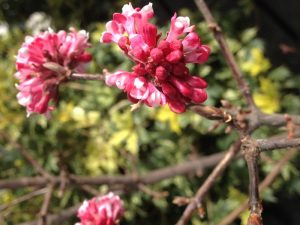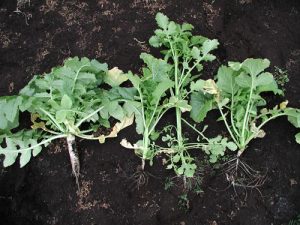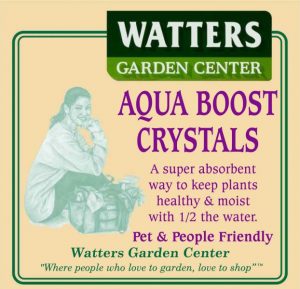Prepare Garden Soil so You can Plant Earlier and Expect Exceptional Crops
 January has been so nice that gardens are starting to show color. Some forsythia and winter blooming jasmine are showing their yellow flowers, lilac buds are huge, and fruit trees are starting to show the ‘popcorn’ stage in their bud growth. ‘Popcorn’ stage defines flower buds that have not opened, but definitely are showing their respective colors of apricots and nectarines. This also happens to be the time, before they fully break from dormancy, to plant these early bloomers.
January has been so nice that gardens are starting to show color. Some forsythia and winter blooming jasmine are showing their yellow flowers, lilac buds are huge, and fruit trees are starting to show the ‘popcorn’ stage in their bud growth. ‘Popcorn’ stage defines flower buds that have not opened, but definitely are showing their respective colors of apricots and nectarines. This also happens to be the time, before they fully break from dormancy, to plant these early bloomers.
Do not frustrate yourself by ordering bare-root plants from an online source only to watch your new plants wither and die. Because ours is an arid, harsh environment, my personal experience has been a 50% mortality rate from bare-root trees, berries, etc. Increase your success by planting fully mature plants with an equally mature root structure. These are mature plants that were transplanted into their final growers’ pots in 2012 and then showcased at the nursery in 2014. By planting a tree or shrub that is this mature, you are assured of its successful growth. Trust me, I have killed a lot of plants over the years until I learned that this formula really works. Transplanted mature plants are better equipped to withstand our spring winds and their deadly drying effect on all new plants.
How can you tell if the potted plant you’re planning to buy has a fully mature root structure that is years in the making or is a bare-root plant? Try pulling the tree out of its pot. If the trunk lifts out of the soil, you don’t want that plant. If the plant and all the soil levitate out of the pot then you know you’re dealing with a fully developed root structure. They rarely cost but a few dollars over their bare-root counterparts, but insure an exceptional garden experience.
My vegetables are not planted yet, but the seeds are plugged and the garden soil has been turned. This is a good opportunity to share how I prepare my gardening soils. My personal gardens are not large. Each is a raised bed measuring 10 feet by 15 feet supplemented by a lot of container gardens. Where I live the soil is just too hard for growing flowers, vegetables, and herbs, so everything is planted above ground. But, I prepare these soils the same way every year and enjoy great gardening success.
 Transforming native soils into a viable garden bed can take up to three years before enough compost, manure, and a few other nutrients have been turned into the soil for idyllic fertile proportions. Stick with it and your soil will perform better every year.
Transforming native soils into a viable garden bed can take up to three years before enough compost, manure, and a few other nutrients have been turned into the soil for idyllic fertile proportions. Stick with it and your soil will perform better every year.
For those of us that have established gardens that are ready for annual revitalization, here is the complete process. For my 10X15-foot raised vegetable bed I add 10 bags of ‘Barnyard Manure’ and six bags of ‘Premium Mulch’. This adds up to a two-inch layer of organic matter to be turned into the existing garden soil to one shovel’s depth.
Before turning this organic matter into the garden I like to add some specific nutrients that will be needed for producing edible crops. There are four organics that make the difference in fruit production and flavor:
- ‘Tomato & Vegetable Food’ 4-4-6 is a locally created organic additive perfect for working into our soils for maximum fruit size and disease resistance. This is a pelletized organic food that is very easy to use. Buy the 20-pound bag so that you have some left after soil preparation. Some of this reserve is for adding to the garden about every 6-8 weeks throughout the growing season.
- ‘Gypsum’ is a chalky material generously spread into the garden. Again, for a couple dollars more you can buy the 40-pound size, also turned into the soil to one shovel’s depth. Focus adding gypsum where your tomatoes, squash, eggplants, and peppers will be planted. This product lowers the pH for better flavor and reduces blossom drop and fruit rot.
- ‘Worm Castings’ are added to the garden at least twice per year, but are especially important as soil is prepared for spring. A 16-quart bag covered my size garden. The enzymes in the castings activate the organisms in your garden so plants are prompted to root more quickly. Worm castings are critical to native soils and to soils that have not been worked in the past year.
 ‘Aqua Boost Crystals’ are soil polymers that have been infused with mycorrhizae and symbiotic fungi. The polymer crystals hold 200 times their weight in water, keeping moisture close to the plant so vegetable skins show less cracking and stay soft and supple. The beneficial mycorrhizae encourage plants to root more deeply while lowering water requirements throughout the season by 50 percent. It’s one of those magic new products that really make a difference in our arid climate.
‘Aqua Boost Crystals’ are soil polymers that have been infused with mycorrhizae and symbiotic fungi. The polymer crystals hold 200 times their weight in water, keeping moisture close to the plant so vegetable skins show less cracking and stay soft and supple. The beneficial mycorrhizae encourage plants to root more deeply while lowering water requirements throughout the season by 50 percent. It’s one of those magic new products that really make a difference in our arid climate.
Turn all four nutrients along with the barnyard manure and premium mulch and you have a soil that will produce like you may never have seen before. Last year my garden produced so many tomatoes that I literally could not process them fast enough. I credit this initial soil preparation for such a bountiful success.
Gardening Class – Sedona landscape designer, Rich Olsen, has accepted an invitation to teach our January 25th class ‘Landscape Designs for Outstanding Mountain Styles’. Last spring Rich taught a similar landscape design class that was standing room only and got rave reviews. With decades of Arizona design experience his remodel ideas just feel right. The class is free, but coming early and bringing your own lawn chair is highly recommended. Class will be held in the back greenhouses at Watters Garden Center.
Until next week, I’ll see you at the garden center.

